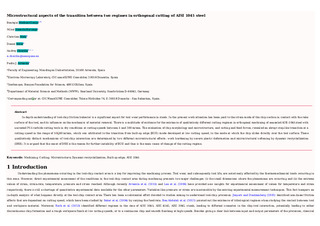Title
Microstructural aspects of the transition between two regimes in orthogonal cutting of AISI 1045 steelxmlui.dri2xhtml.METS-1.0.item-contributorOtherinstitution
https://ror.org/023ke8y90https://ror.org/01jdpyv68
https://ror.org/01cc3fy72
Version
http://purl.org/coar/version/c_ab4af688f83e57aa
Rights
© 2018 ElsevierAccess
http://purl.org/coar/access_right/c_abf2Publisher’s version
https://doi.org/10.1016/j.jmatprotec.2018.05.016Published at
Journal of Materials Processing Technology Vol. 260. Pp. 87–96. October, 2018xmlui.dri2xhtml.METS-1.0.item-publicationfirstpage
87xmlui.dri2xhtml.METS-1.0.item-publicationlastpage
96Publisher
ElsevierKeywords
Machining
Cutting
Microstructure
Dynamic recrystallization ... [+]
Cutting
Microstructure
Dynamic recrystallization ... [+]
Machining
Cutting
Microstructure
Dynamic recrystallization
Built-up edge
AISI 1045 [-]
Cutting
Microstructure
Dynamic recrystallization
Built-up edge
AISI 1045 [-]
Abstract
In depth understanding of tool-chip friction behavior is a significant aspect for tool wear performance in steels. In the present work attention has been paid to the strain mode of the chip section in ... [+]
In depth understanding of tool-chip friction behavior is a significant aspect for tool wear performance in steels. In the present work attention has been paid to the strain mode of the chip section in contact with the rake surface of the tool, and its influence on the mechanics of material removal. There is a multitude of evidence for the existence of qualitatively different cutting regimes in orthogonal machining of annealed AISI-1045 steel with uncoated P15 carbide cutting tools in dry conditions at cutting speeds between 5 and 200 m/min. The evaluation of chip morphology and microstructure, and cutting and feed forces, revealed an abrupt step-like transition at a cutting speed in the range of 50–60 m/min, which was attributed to the transition from built-up edge (BUE) mode developed at low cutting speed, to the mode at which the chip slides directly over the tool surface. These qualitatively distinct mechanisms of tool-chip interaction are determined by two different microstructural effects: work hardening by severe plastic deformation and microstructural softening by dynamic recrystallization (DRX). It is argued that the onset of DRX is the reason for further instability of BUE and thus is the main cause of change of the cutting regime. [-]
xmlui.dri2xhtml.METS-1.0.item-sponsorship
Gobierno Vasco-Eusko Jaurlaritzaxmlui.dri2xhtml.METS-1.0.item-projectID
info:eu-repo/grantAgreement/GV/Convocatoria de ayudas a la Investigación básica y-o aplicada 2014-2015/PI_2014_1_116/CAPV/Estudio de la influencia de la microestructura de aceros y superaleaciones base níquel en la maquinabilidad e integridad superficial de componentes mecanizados/MICROMAQUINTECollections
- Articles - Engineering [683]






















